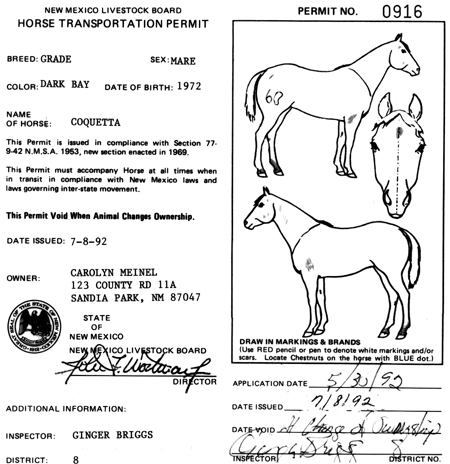Back Country Horsemen
A few days after getting Coquetta, my neighbor to the southeast,
Arlene Walsh, asked me to join the Back Country Horsemen of America
. This is a national organization devoted to keeping public lands
open to horseback riders. We figure horses should be a natural
part of the wilderness. After all, they originated here in the
Southwest. It was only 10,000 years ago that people hunted horses
to extinction. When the Spaniards arrived, their horses took
to the wild and thus, as far as I am concerned, righted a great
environmental wrong.
Our opponents are self-described environmentalists who want
to wipe out wild horses again. They don't want them in the wilderness,
not even as visitors, chaperoned by humans. They cloak their
hunger to extirpate horses with fancy environmentalist talk.
To fight these people, we need allies. We make them the hard
way by doing volunteer work on public lands. Our project for
the morning of May 31, 1992, was to make it easier for antelope
to get to a water hole on Bureau of Land Management (BLM) land.
Arlene wanted to make sure I hauled Coquetta to the day's work
site without breaking the law. The authorities fight rustlers
by requiring hauling permits. Every now and then they stop a
vehicle that is hauling livestock and check to make certin everything
is in order.
Since I'd never seen news stories about rustlers, I figured
they were just being extra careful. Soon my opinion would change.
Early in the morning of May 30th, we met an officer of the
New Mexico Livestock Board at her place. I showed my sale agreement,
and got permit number 916.
Early the next morning, we all met at the junction of Interstate
40 and State Highway 6 to caravan deep into the backcountry.
We headed south, then west on a red dirt track. We angled deep
into a land of red and yellow sandstone mesas toped with black
volcanic rocks south of the Acoma Pueblo.
It was a dry spring. Our vehicles rattled over a washboard
road covered with red dust. We raised such a cloud of dust that
most of the convoy became blinded and took a wrong turn. Those
of us in the lead waited at a group of corrals and a water tank
until our leader retrieved the others. I let Coquetta out to
stretch her legs. She rolled in the dust and shook it off.
Our first task was to figure out how to get to the work site.
The concept was to get on our horses and head west. The reality
was a deep arroyo across our path. People rode north and south
trying to find a way to get through it. Everywhere, dense mesquite
and steep banks blocked the way.
After about ¾ hour all the folks that had gotten lost
in the dust arrived and saddled up, yet we still hadn't figured
out where to cross the arroyo.
What the heck. I gave Coquetta her head. She took off, dit-dit-dit-dit,
with her swift singlefoot gait, headed south about 100 yards,
pushed through some tamarisk bushes, and there was a well-worn
trail through the arroyo.
On the other side, Coquetta begged to get up and go like she'd
never begged before. A teenage boy on a mule cantered up to us.
"Let's run," he called.
I let Coquetta show me how fast she had to go to break into
a canter, then a gallop. After a run of a mile or so we came
to a Chevy ¾ ton pickup with a BLM logo, parked on the
other side of a barbed wire fence.
Why the heck, if a pickup could get to the work site, did
the rest of us have to come in on horseback across that arroyo?
The big deal was that the holder of the grazing rights, the Acoma
Pueblo, didn't care to have lots of random people driving around
their ranch. A strange truck would normally mean a cattle rustler
or poacher.
I walked Coquetta a bit to cool down, then unsaddled her and
wiped the sweat off. We tied her and the mule side by side. As
we walked over to meet the BLM men, I looked back. Coquetta and
the mule were making sweet sounds and nuzzling each other.
We soon found out another reason to ride to this site instead
of drive. The two BLM men had us get into their pickup and drove
us to the far end of the work area. The dirt track was so bad,
it felt like the truck had no shocks at all.
Our job, they explained, was to remove several hundred yards
worth of the bottom strand of barbed wire from the fence and
replace it with smooth wire. "Antelope don't jump fences,"
said one of the BLM men. "They crawl underneath. Along here
is where they crawl under to get to the water hole. We keep on
finding their babies here, dead from thirst. We figure they are
afraid to crawl under the barbed wire."
At the end of our day's work, once again Coquetta and the
mule begged to run. Because we would be trailering them right
away, we didn't let them go fast enough to work up a sweat. Even
so, again we left the rest of the work crew way behind.
I was beginning to suspect that my homely old mare was pretty
darn good.
Next chapter: Sandia's Foals --->>
Back to the Table of Contents for
Killer Buyer: True Adventures of a New Mexico Horse Dealer

Coquetta's hauling papers. The birthdate of 1972 was only
a guess. We later learned she was more like thirty at this time.

